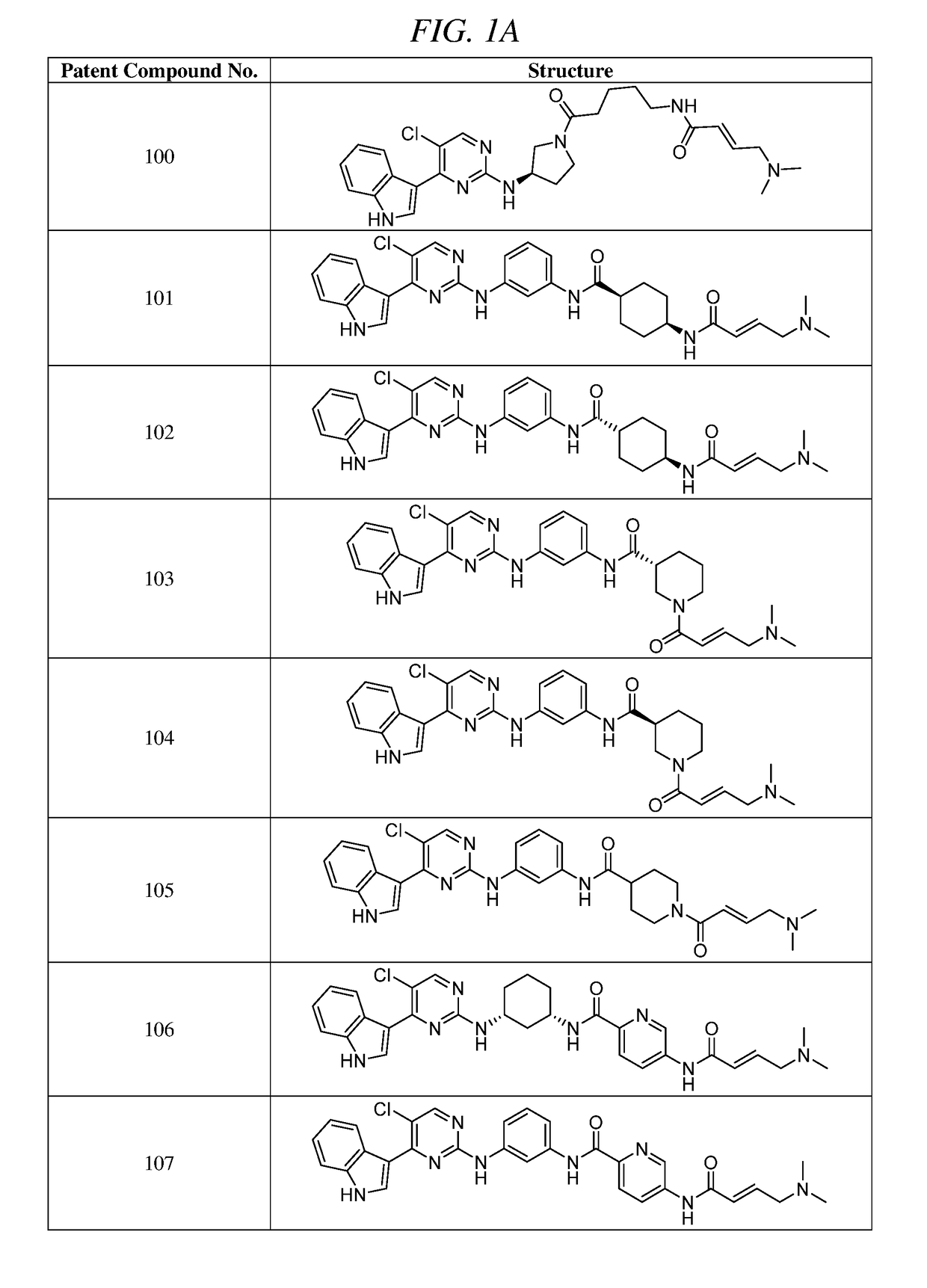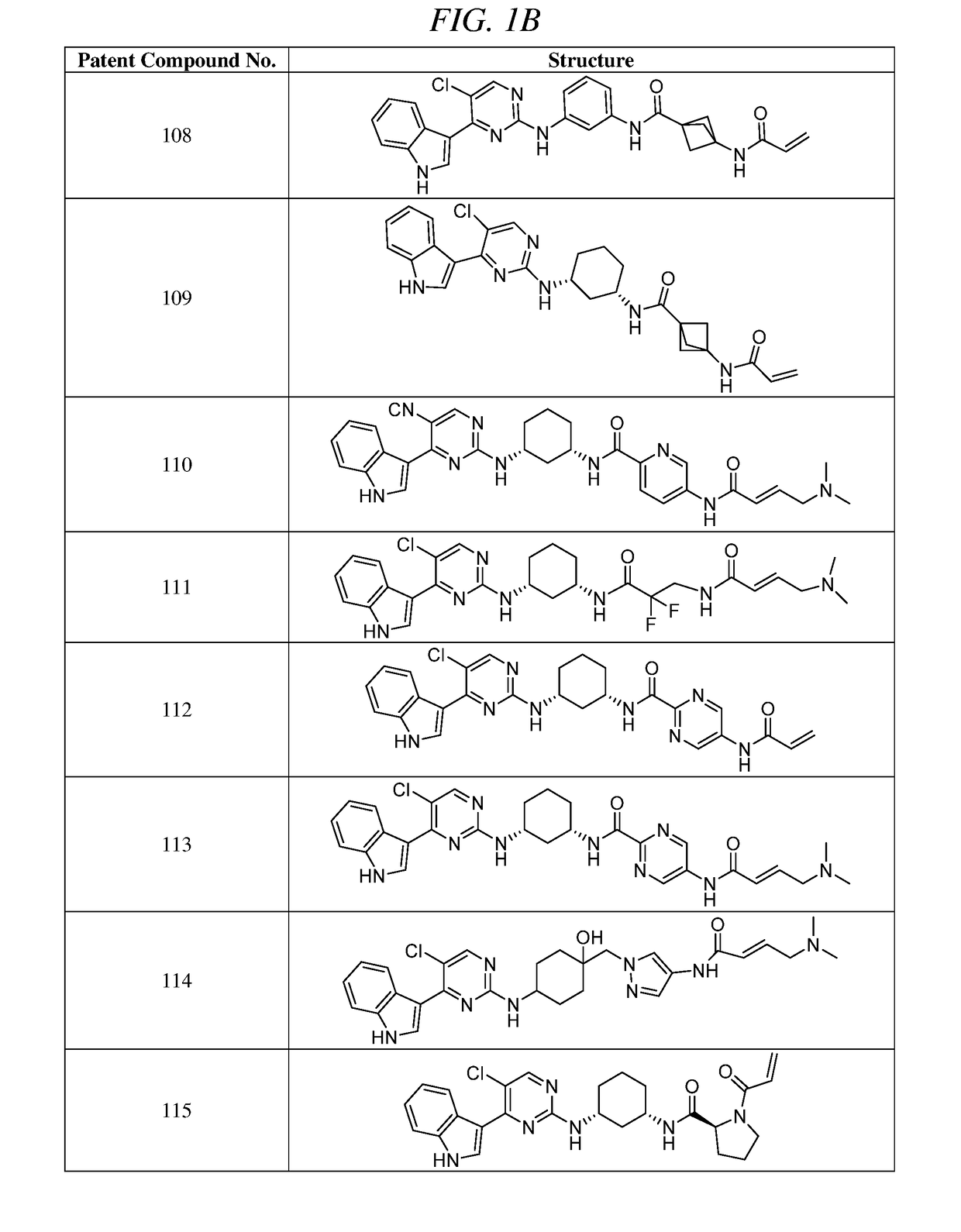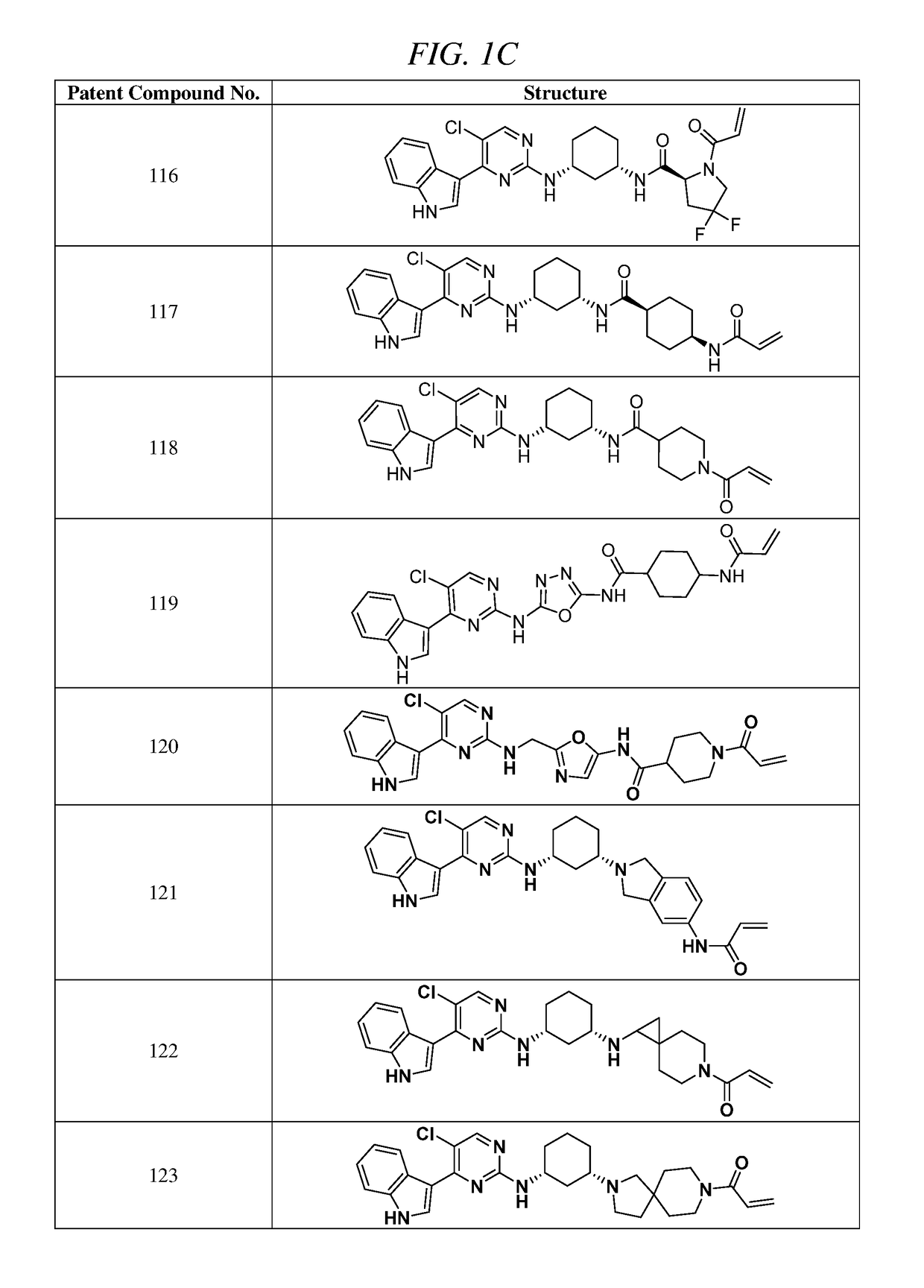Inhibitors of cyclin-dependent kinase 7 (CDK7)
a cyclin-dependent kinase and inhibitor technology, applied in the field of inhibitors of cyclin-dependent kinase 7 (cdk7), can solve the problems of hampered discovery of selective inhibitors of cdk7 and anti-proliferation activity
- Summary
- Abstract
- Description
- Claims
- Application Information
AI Technical Summary
Benefits of technology
Problems solved by technology
Method used
Image
Examples
example 1
Synthesis of (E)-N-(3-(5-chloro-4-(1H-indol-3-yl)pyrimidin-2-ylamino)phenyl)-5-(4-(dimethylamino)but-2-enamido)picolinamide (Compound 107)
N1-(5-chloro-4-(1-(phenylsulfonyl)-1H-indol-3-yl)pyrimidin-2-yl)benzene-1,3-diamine
[0252]
[0253]A solution of 3-(2,5-dichloropyrimidin-4-yl)-1-(phenylsulfonyl)-1H-indole (1.5 g, 3.70 mmol) and m-phenylenediamine (400 mg, 3.70 mmol) in NMP (15 mL) was heated 15 min at 175° C. (mW). The cooled mixture was diluted with EtOAc (100 mL) and water (50 mL). The layers were separated and the aqueous layer was extracted with EtOAc (3×50 mL). The combined organics were washed with brine (50 mL) dried (MgSO4), filtered and evaporated to dryness. The mixture was purified by SiO2 column (DCM / EtOAc 0 to 30% gradient) and afforded the title compound (606 mg, 1.27 mmol, 34%) as a pale brown solid.
5-amino-N-(3-(5-chloro-4-(1-(phenylsulfonyl)-1H-indol-3-yl)pyrimidin-2-ylamino)phenyl)picolinamide
[0254]
[0255]To a solution of N1-(5-chloro-4-(1-(phenylsulfonyl)-1H-indol-...
example 2
Synthesis of (E)-N-(3-(5-chloro-4-(1H-indol-3-yl)pyrimidin-2-ylamino)phenyl)-1-(4-(dimethylamino)but-2-enoyl)piperidine-4-carboxamide (Compound 105)
tert-butyl 4-(3-(5-chloro-4-(1-(phenylsulfonyl)-1H-indol-3-yl)pyrimidin-2-ylamino)phenylcarbamoyl)piperidine-1-carboxylate
[0260]
[0261]To a solution N1-(5-chloro-4-(1-(phenylsulfonyl)-1H-indol-3-yl)pyrimidin-2-yl)benzene-1,3-diamine prepared as in Example 1 (150 mg, 0.315 mmol), N-Boc-isonipecotic acid (87 mg, 0.378 mmol) and Et3N (132 μL, 0.945 mmol) in DMF (3 mL) was added, followed by HBTU (179 mg, 0.473 mmol). The mixture was stirred overnight at room temperature, diluted with EtOAc (20 mL), washed with sat. NaHCO3 (3×5 mL), brine (2×5 mL), and dried (MgSO4), then filtered and evaporated to dryness. The residue was purified by SiO2 chromatography (DCM / EtOAc 0 to 100% gradient) and afforded the title compound (210 mg, 0.306 mmol, 97%) as a pale cream solid.
tert-butyl 4-(3-(5-chloro-4-(1H-indol-3-yl)pyrimidin-2-ylamino)phenylcarbamoyl)p...
example 3
Synthesis of (E)-N-(5-((R)-3-(5-chloro-4-(1H-indol-3-yl)pyrimidin-2-ylamino)pyrrolidin-1-yl)-5-oxopentyl)-4-(dimethylamino)but-2-enamide (Compound 100)
(3R)-tert-butyl 3-(5-chloro-4-(1-(phenylsulfonyl)-1H-indol-3-yl)pyrimidin-2-ylamino)pyrrolidine-1-carboxylate
[0268]
[0269]A solution of 3-(2,5-dichloropyrimidin-4-yl)-1-(phenylsulfonyl)-1H-indole (2.50 g, 6.18 mmol), (R)-tert-butyl 3-aminopyrrolidine-1-carboxylate (1.209 g, 6.49 mmol) and diisopropylethylamine (1.08 mL, 6.18 mmol) in NMP (16 mL) was heated for 15 min at 135° C. The mixture was diluted with EtOAc (50 mL), washed with water (10 mL), brine (10 mL), dried (MgSO4), then filtered and evaporated to dryness. The residue was purified by SiO2 chromatography (DCM / EtOAc 0 to 40% gradient) and afforded the title compound (2.378 g, 4.29 mmol, 69%) as a white solid.
5-chloro-4-(1-(phenylsulfonyl)-1H-indol-3-yl)-N—((R)-pyrrolidin-3-yl)pyrimidin-2-amine
[0270]
[0271]Trifluoroacetic acid (7 mL, 85.8 mmol) was added to a stirring solution o...
PUM
 Login to View More
Login to View More Abstract
Description
Claims
Application Information
 Login to View More
Login to View More - R&D
- Intellectual Property
- Life Sciences
- Materials
- Tech Scout
- Unparalleled Data Quality
- Higher Quality Content
- 60% Fewer Hallucinations
Browse by: Latest US Patents, China's latest patents, Technical Efficacy Thesaurus, Application Domain, Technology Topic, Popular Technical Reports.
© 2025 PatSnap. All rights reserved.Legal|Privacy policy|Modern Slavery Act Transparency Statement|Sitemap|About US| Contact US: help@patsnap.com



